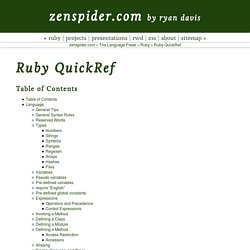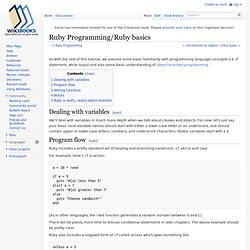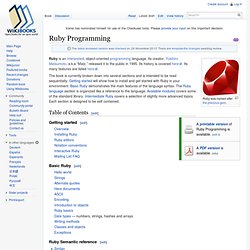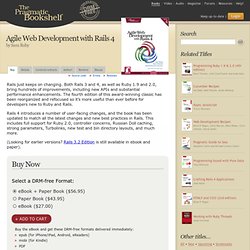

Ruby on Rails Tutorial. Zenspider.com by ryan davis. Table of Contents Language General Tips These are tips I’ve given over and over and over and over… Use 2 space indent, no tabs.

Ruby Quick Reference Guide. New To Ruby? SketchUp Ruby API. RubyLEARNER. Basics of ruby programming. Simple Ruby Examples. From Techotopia Purchase and download the PDF and ePub versions of this Ruby eBook for only $8.99 Not only is Ruby a flexible scripting language in terms of its syntax, it is also highly flexible in the ways in which scripts can be executed.

In this chapter we will begin by looking at some simple Ruby examples, and then look at the variety of different ways Ruby code can be executed. [edit] The Most Basic Ruby Example Programming guides tend to follow the tradition of using "Hello World" as the first example of using a programming language. On Linux or UNIX derived operating systems: Programming Ruby: The Pragmatic Programmer's Guide. Ruby Programming/Ruby basics. As with the rest of this tutorial, we assume some basic familiarity with programming language concepts (i.e. if statement, while loops) and also some basic understanding of object-oriented programming.

We'll deal with variables in much more depth when we talk about classes and objects. For now, let's just say your basic local variable names should start with either a lower case letter or an underscore, and should contain upper or lower case letters, numbers, and underscore characters. Index of Files, Classes & Methods in Ruby 1.9.3. Ruby Programming. Ruby is an interpreted, object-oriented programming language.

Its creator, Yukihiro Matsumoto, a.k.a “Matz,” released it to the public in 1995. Its history is covered here. Its many features are listed here. The book is currently broken down into several sections and is intended to be read sequentially. What is ruby? Documentation. Programming With Ruby Episode 1, Introduction. Ruby Programming Tutorial 1 (Input and Output) Ruby Programming for Beginners.
Ruby Trick Shots: 24 Ruby Language Tips and Tricks. Learn to program using Ruby - Part 8: Blocks. FULL Ruby Programming Tutorial - FAST AND EASY! Introduction to Ruby Programming - Online Course. Learn how to create an interactive Web blog that allows visitors to register and post articles and comments.

You'll see how to use the Ruby on Rails framework environment to create a full-featured Web blog using the Ruby programming language and the MySQL database server. We'll walk through the development of a complete Web blog application. During the course, you'll see step-by-step how to create all of the software and database objects used in the application. Ruby Basic Tutorial. Troubleshooters.Com, Code Corner and Ruby Revival Present Ruby Basic Tutorial Copyright (C) 2005 by Steve Litt Note: All materials in Ruby Revival are provided AS IS.

By reading the materials in Ruby Revival you are agreeing to assume all risks involved in the use of the materials, and you are agreeing to absolve the authors, owners, and anyone else involved with Python Patrol of any responsibility for the outcome of any use of these materials, even in the case of errors and/or omissions in the materials. If you do not agree to this, you must not read these materials. To the 99.9% of you honest readers who take responsibility for your own actions, I'm truly sorry it is necessary to subject all readers to the above disclaimer.
New Ruby 1.9 Features, Tips & Tricks. Agile Web Development with Rails. About this Book 456 pages Published: Release: P2.0 (2014-03-31) ISBN: 978-1-93778-556-7 Ruby on Rails helps you produce high-quality, beautiful-looking web applications quickly.

You concentrate on creating the application, and Rails takes care of the details. Tens of thousands of developers have used this award-winning book to learn Rails. It’s a broad, far-reaching tutorial and reference that’s recommended by the Rails core team. Rails has evolved over the years, and this book has evolved along with it.
Learn Web Development with the Ruby on Rails Tutorial. Michael Hartl Contents Foreword My former company (CD Baby) was one of the first to loudly switch to Ruby on Rails, and then even more loudly switch back to PHP (Google me to read about the drama).

This book by Michael Hartl came so highly recommended that I had to try it, and the Ruby on Rails Tutorial is what I used to switch back to Rails again. Though I’ve worked my way through many Rails books, this is the one that finally made me “get” it. The linear narrative is such a great format. Enjoy! Derek Sivers (sivers.org) Founder, CD Baby Acknowledgments The Ruby on Rails Tutorial owes a lot to my previous Rails book, RailsSpace, and hence to my coauthor Aurelius Prochazka. I’d like to acknowledge a long list of Rubyists who have taught and inspired me over the years: David Heinemeier Hansson, Yehuda Katz, Carl Lerche, Jeremy Kemper, Xavier Noria, Ryan Bates, Geoffrey Grosenbach, Peter Cooper, Matt Aimonetti, Gregg Pollack, Wayne E. About the author. Code School - TryRuby. Ruby-Doc.org: Documenting the Ruby Language. Ruby for Newbies. Ruby programming tutorial. See also: Part One and Part Three of this series We ended the last lesson by creating two new classes: a Thing class and a Treasure class.

In spite of the fact that these two classes shared some features (notably both had a ‘name’), there was no connection between them. In a real-world program, classes may often share numerous features and, if we aren’t careful, we’ll end up repeatedly writing the same code many times in order to deal with similar features in different classes.
It therefore makes sense to create a class hierarchy in which the Treasure class is a descendant of the Thing class. The behaviour of Things in general will be coded in the Thing class itself. As a general rule, when creating a class hierarchy, the classes with the most generalised behaviour are higher up the hierarchy than classes with more specialist behaviour. Exploring Everyday Things with R and Ruby. Book_of_ruby of source code, because there is no classification, temporarily p O s www.pudn.com.